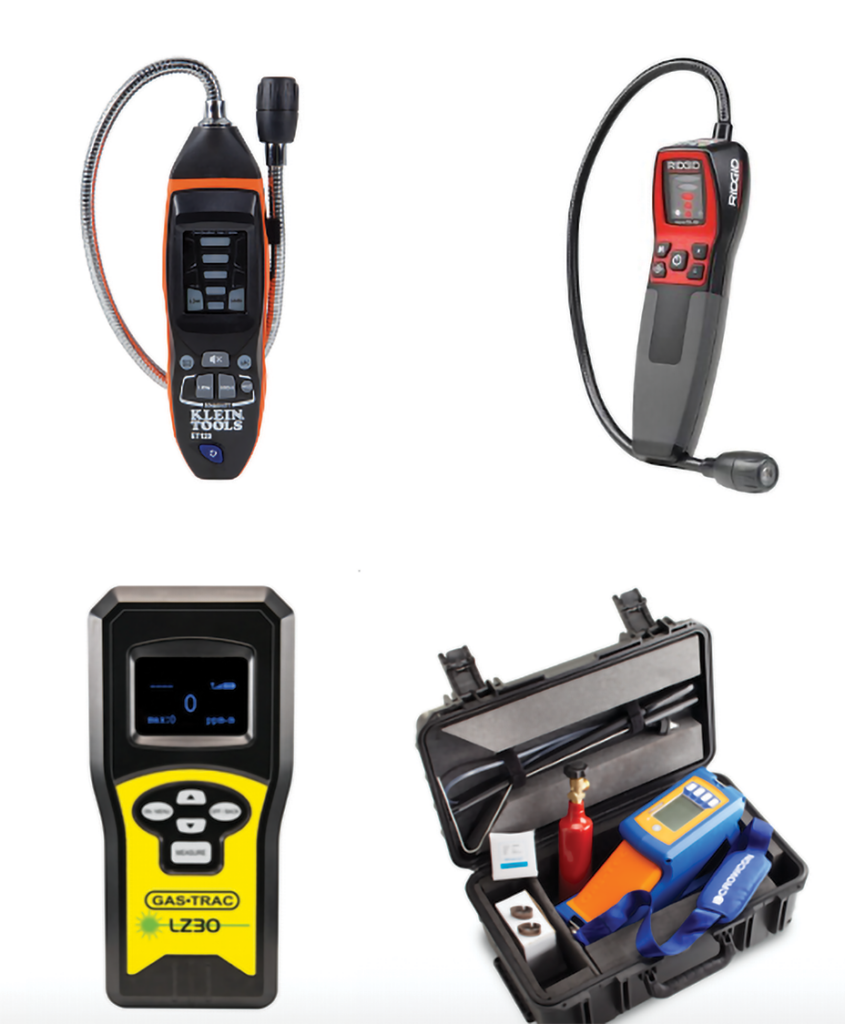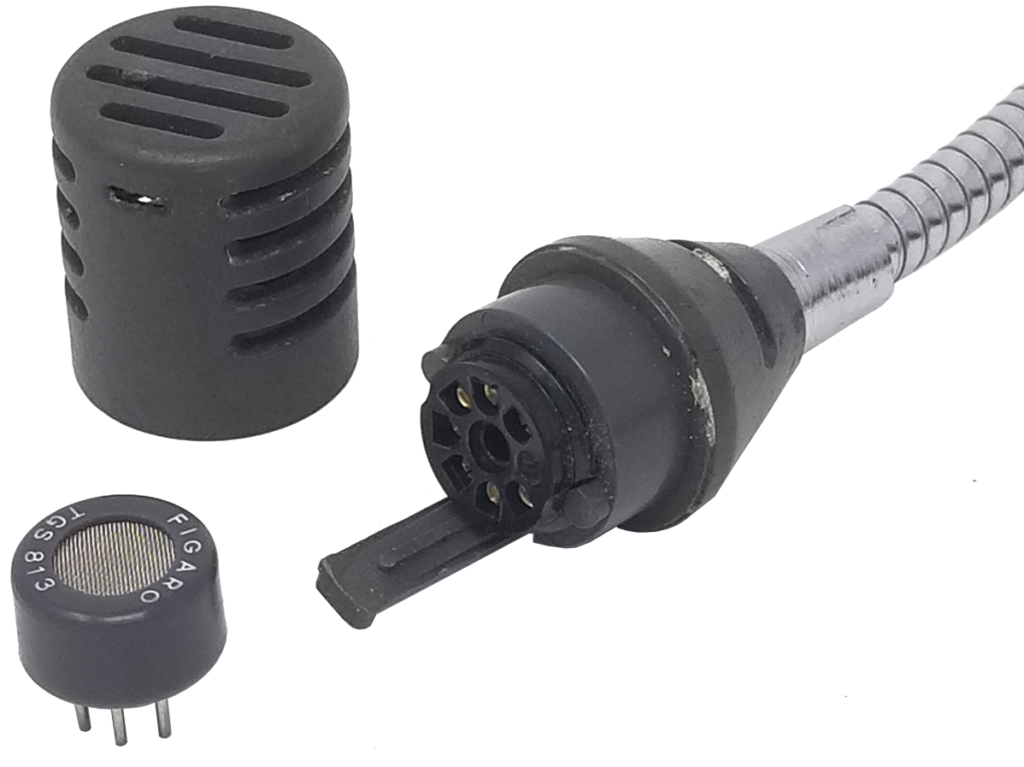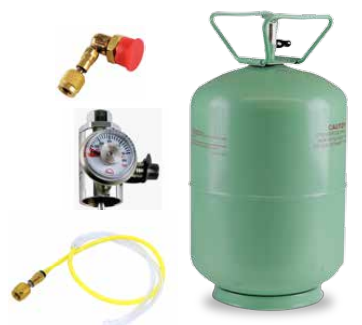A-4.4 Combustible Gas Indicators
Gas leaks are very dangerous because even a small gas leak may gradually build up to an explosive concentration. Combustible gas indicators (CGIs), also known as gas leak detectors, are used to identify the presence of gaseous products from a pipeline or other contaminants in an area where they should not be.
Types of Leak Detectors
Gas leak detectors come in two main forms: portable devices and fixed gas detectors.
Portable detectors monitor the atmosphere around personnel and are either handheld or worn on clothing or a belt/harness. These gas detectors are usually battery-operated. They transmit warnings via audible and visible signals, such as alarms and flashing lights, when gas vapours are detected.
Fixed detectors are generally mounted near the process area of a plant or control room, or an area to be protected, such as a residential bedroom. Generally, fixed sensors used in an industrial application are installed on fixed structures and a cable connects the detectors to a continuous monitoring system.
Gas detectors can also be classified according to the operation mechanism or sensor (Figure 1). Some common sensor types include:
- Electrochemical sensors
- Electrocatalytic sensors
- Infrared sensors
- Flame ionization detectors

Electrochemical Sensors
Electrochemical gas sensors measure the concentration of a target gas by oxidizing or reducing the target gas at an electrode semiconductor. The absorption or desorption of the gas on the metal oxide semiconductor changes either the conductivity or the resistivity. The resulting current is measured and compared to a known baseline value.
Electrocatalytic Sensors
Electrocatalytic (catalytic bead) sensors function on the principle that a combustible gas can be oxidized to produce heat. The resulting temperature change can be converted to a sensor signal. Catalyst sensors are often used to detect hydrocarbons and rely on the presence of oxygen to function.
Flame Ionization Detectors
Flame ionization detectors pass a sample through a hydrogen-air flame. The hydrogen-air flame alone creates few ions, but any hydrocarbons burned in the sample produce an increase in ions proportional to the concentration of the hydrocarbons. A polarizing voltage attracts these ions to a collector plate located near the flame, and upon hitting the plate, they induce a current that is measured. The kit includes a portable hydrogen cylinder.
Infrared Sensors
Infrared (IR), also known as laser, sensors are based on absorption of infrared radiation as it passes through a volume of gas. The laser light beam emits a specific wavelength absorbed by methane. When the laser hits methane, the methane absorbs some laser energy. The concentration of gas is proportional to the amount of specific IR light absorbed and is displayed in ppm concentrations. This type of sensor does not have to be placed into the gas to detect it and can be used for remote sensing at distances up to 30 metres.
The type of sensor the detector incorporates is not as significant to the operator as how to use and maintain it. Although the detectors often look similar, the type of sensor system used will affect the calibration, operating, and maintenance procedures.
Investigating Gas Leaks
First, if responding to a gas leak call, safety is the primary concern.
If at any time you experience very high readings that are near or above the lower explosive limits (LEL) of the fuel, immediately execute the emergency make-safe precautions.
This checklist outlines the steps to take when responding to a gas leak call.
Steps to Take When Attending a Gas Leak Call
- Prepare. Activate the combustible gas detector. Gather other tools, such as soap solution, manometer, safety flashlight (Class 1), and pipe wrenches.
- Knock on the door. Do not ring the bell because a spark could ignite the gas.
- Communicate with the occupants.
- Inquire about the situation.
- Instruct occupants not to smoke or use any electrical equipment.
- Take readings.
- Determine if the gas supply is natural gas or propane.
- Natural gas: investigate high locations initially.
- Propane: investigate low locations initially.
- If any reading is near or above the LEL, execute emergency make-safe precautions.
- Determine if the gas supply is natural gas or propane.
- If a leak is detected, cut off ignition sources.
- Open the master breaker at the electrical panel.
- If readings are below the LEL, determine the source of the leak.
-
- Use your nose and a gas detector to zero in on the location of the leak.
- When closing manual valves at gas appliances, listen for the sound of gas passing.
- If readings are strong but the smell is faint, there may be an outside below-ground leak that has infiltrated the building.
Emergency Make-Safe
- Evacuate occupants from the building, including yourself.
- In larger buildings, instruct the building manager to activate the emergency evacuation plan.
- Do not cross-ventilate because you do not want to move a potentially explosive concentration to a possible source of ignition.
- On your way out, turn off gas riser valve or the propane cylinder/tank service valve.
- Do not return to a building to turn off the main shutoff valve. If you happen to pass by the service riser as you exit the building, and you have wrench with you, shut it off.
- Call for help when you are a safe distance from the building. Contact the police department and gas utility.
Leak Detector Operation
There are a wide range of gas sensor products available. The type that is best suited depends on the working environment and what types of gas might be present, such as natural gas, carbon monoxide, or airborne organic compounds.
The following list represents some common operating guidelines. It is imperative that an operator read and understand the manufacturer’s manual fully before using any detector.
- The detector performs an automatic zero during start up. To ensure proper zero, always start the detector in a clean-air environment similar in temperature and relative humidity to the environment where the instrument will be used. Some units may require the unit to be manually zeroed.
- Some detectors have accessories that need to be connected before the unit is turned on, such as external probes or hydrogen cylinders for flame ionization units.
- Detectors have some form of low battery signal and or LED symbol.
- Once initial calibration is complete, use a combustible gas source (such as an unlit lighter) to confirm that the gas detector senses the gas. If the gas detector does not sense the gas, do not use the unit until it has been properly serviced.
- The detector may have one or more of the following methods of alarm signals: audible beeps, Geiger counter-style ticks, vibration alerts, light signals, or an LED concentration display.
- Some detectors use an internal pump; an initial test of the pump and tubing may be required.
- Enter the area to be monitored. Pay close attention to the gas-level indicators. As gas levels increase, alarm levels increase. If the concentration of fuel gas is near or above the lower explosive limit, there is explosion potential, and you must take immediate actions to make the area safe.
- If the gas concentration is well below the LEL, you can proceed to investigate further. Use the gas detector to find areas of lower gas concentration and follow it back to the source. In a piping system, trace the system, stopping at the joints to monitor the gas levels. For detectors that use Geiger-style ticks, as the sensor head moves closer to a leak source, the tick rate increases. When the tick becomes a steady tone, rotate the thumbwheel in a clockwise direction while keeping the sensor head in the same position. This slows down the tick and allows the operator to find a higher concentration using the same procedure. The tick rate increases as the higher concentration of gas increases as you move closer to the leak source.
- If the sensor is overexposed to some gases, the unit may take an extended period of time to return to calibrated ready condition.
Maintenance
- To increase battery life, always turn the unit off when not in use.
- If the batteries require replacement, always change them in an environment free of combustible gases.
- Remove the batteries before any long period of storage or shipping to avoid battery leakage.
- Some types of detectors do not require calibration other than that done at regular start up.
- For some portable detectors, replacement sensors are available so that an operator can replace the expired sensor (Figure 2).
- Some detectors require that sensor calibration or replacement be performed by an authorized service centre.
- Some manufacturers have calibration kits complete with regulator and calibration gas available for purchase (Figure 3).


 Self-Test A-4.4 Combustible Gas Indicators
Self-Test A-4.4 Combustible Gas Indicators
Complete Self-Test A-4.4: Combustible Gas Indicators and check your answers.
If you are using a printed copy, please find Self-Test A-4.4 and Answer Key at the end of this section. If you prefer, you can scan the QR code with your digital device to go directly to the interactive Self-Test.

References
Skilled Trades BC. (2021). Book 1: Fuel gas systems, Heating and cooling systems. Plumber apprenticeship program level 2 book 1 Harmonized. Crown Publications: King’s Printer for British Columbia.
Trades Training BC. (2021). A-4: Use technical instruments and testers. In: Plumber Apprenticeship Program: Level 2. Industry Training Authority, BC.
Media Attributions
All figures are used with permission from Skilled Trades BC (2021) unless otherwise noted.
Also called a gas leak detector, this device is used to detect and measure the presence of flammable gases in the air, it helps to identify potentially hazardous levels of gases that could ignite or pose health risks. (Section A-4.4)
Lower explosive limits (LEL) is the lowest concentration of a flammable gas or vapor in the air that can ignite or explode when there is a source of ignition present. It's important to know LEL to stay safe when working with potentially explosive gases. (Section A-4.4)


